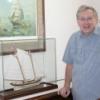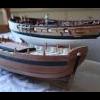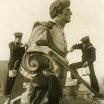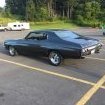-
Posts
338 -
Joined
-
Last visited
Reputation Activity
-
 Pete Jaquith got a reaction from Bill Morrison in Constitution by jfinan - FINISHED - BlueJacket Shipcrafters
Pete Jaquith got a reaction from Bill Morrison in Constitution by jfinan - FINISHED - BlueJacket Shipcrafters
Jfinan,
I have attached pictures of this stage in my Newsboy build here in MSW. I used sharp gouges to carve vertically and remove excessive bulwark material. A dial caliper was used to monitor thickness.
Pete
-
 Pete Jaquith got a reaction from Jthibo1977 in Coppering the Ship Model Hull
Pete Jaquith got a reaction from Jthibo1977 in Coppering the Ship Model Hull
Various techniques including copper paint, individual copper plates, photo etched plates, and self adhesive copper tape have been used by ship modelers to simulate the copper sheathing used for under water hull protection on both naval and merchant ships from the late 1700’s thru the late 1800’s. The following notes describe the technique selected for my Topsail Schooner "Eagle" of 1847 build.
Test Pieces – Test pieces were prepared to evaluate the installation process and appearance of various methods including individual plates, individual plates cut from self adhesive tape, strips of copper tape, and both plain and embossed plates. The selected approach was individual plates cut from self adhesive copper tape with embossed nail heads on the exposed plate edges only.
Copper Material – The material used for copper sheathing was .0015” x ¼” wide self adhesive copper tape purchased from Blue Jacket Ship Crafters.
Plate Fabrication – The individual copper plates were cut from self adhesive copper tape using a Carl Rotary Trimmer from Staples Office Supply. The plates were ¼” x ¾” (16” x 48” full size at 1:64 scale). The individual plates were then embossed from the back side using a fine pounce wheel.
Hull Preparation – After filling and sanding any minor dings, holes, etc. on the lower hull and completion of topside painting (acrylic paints); the topside and bare lower hull were sealed with three coats of Minwax Wipe-On-Poly (oil based wiping varnish). A hard smooth surface is necessary for tape adhesion, and a smooth surface is important as any defects will show through the thin copper foil.
Hull Layout – With the model resting in its building cradle, the waterline was laid out using a surface gauge. The gore line was then located using the copper sheathing layout taken from a similar size merchant hull plans (whaler "Kate Cory"). The plate layout consists of upper and lower gore strakes with no dressing belt. The individual copper plate strakes were laid out using a tick strip working up from the keel. The water line, gore line, and individual plate strakes were then marked on the model hull using narrow strips of blue masking tape. Note that properly locating the waterline and gore line are critical as I have seen models where they dip down badly in the stern area.
Plate Installation – Individual copper plates were applied using the masking tape strips as a guide and working from the keel up and the stern post forward. The plates were overlapped approximately 1/32” and butts were staggered like brick work. A fair amount of fitting was required in the upper stern area due to the hull shape, and the upper corners of the plates were cut off for those plates that crossed the gore line and waterline. After installation, all copper foil plates were rubbed down with a soft rag.
Protective Finish – After installation, I cleaned the copper plates with denatured alcohol and applied three coats of Minwax Wipe-On-Poly to seal and protect the copper surface. After approximately 10 months, the copper sheathing is beginning to show some tarnish under the varnish finish. On future builds, I may just choose to clean the copper plates and let them tarnish naturally.
While the above technique is only an approximation of full size practice as the nail pattern would have covered the complete plate and would hardly be visible at this scale, I was pleased with the overall effect. As noted; critical items in the application include having a smooth hard surface, layout of the waterline/gore line, and holding the plate strakes straight.
Brigantine "Newsboy" 1854 Installation – Following completion of the Topsail Schooner "Eagle", my next ship model was the Brigantine "Newsboy" of 1854 (also in 1:64 scale). The copper sheathing installation on "Newsboy" was similar to "Eagle" with the following exceptions:
1. Due to her finer hull lines, I chose to model the copper sheathing layout after the clipper ship "Flying Fish" of 1851. The copper sheathing layout consisted of an upper and lower gore with a single dressing strake at the water line.
2. The copper plate fabrication and installation was similar to "Eagle". Based on the recommendation of friends at the USS Constitution Model Shipwrights Guild, I elected not to emboss the copper plates with simulated nails. I was pleased with the result, and plan to follow this practice on future models of American Merchant Sail from the mid 1800’s.
The following pictures illustrate copper sheathing installation on the Maine Topsail Schooner "Eagle" 1847 and Brigantine "Newsboy" of 1854.
Pete Jaquith
Shipbuilder
-
 Pete Jaquith got a reaction from GrandpaPhil in Coppering the Ship Model Hull
Pete Jaquith got a reaction from GrandpaPhil in Coppering the Ship Model Hull
Various techniques including copper paint, individual copper plates, photo etched plates, and self adhesive copper tape have been used by ship modelers to simulate the copper sheathing used for under water hull protection on both naval and merchant ships from the late 1700’s thru the late 1800’s. The following notes describe the technique selected for my Topsail Schooner "Eagle" of 1847 build.
Test Pieces – Test pieces were prepared to evaluate the installation process and appearance of various methods including individual plates, individual plates cut from self adhesive tape, strips of copper tape, and both plain and embossed plates. The selected approach was individual plates cut from self adhesive copper tape with embossed nail heads on the exposed plate edges only.
Copper Material – The material used for copper sheathing was .0015” x ¼” wide self adhesive copper tape purchased from Blue Jacket Ship Crafters.
Plate Fabrication – The individual copper plates were cut from self adhesive copper tape using a Carl Rotary Trimmer from Staples Office Supply. The plates were ¼” x ¾” (16” x 48” full size at 1:64 scale). The individual plates were then embossed from the back side using a fine pounce wheel.
Hull Preparation – After filling and sanding any minor dings, holes, etc. on the lower hull and completion of topside painting (acrylic paints); the topside and bare lower hull were sealed with three coats of Minwax Wipe-On-Poly (oil based wiping varnish). A hard smooth surface is necessary for tape adhesion, and a smooth surface is important as any defects will show through the thin copper foil.
Hull Layout – With the model resting in its building cradle, the waterline was laid out using a surface gauge. The gore line was then located using the copper sheathing layout taken from a similar size merchant hull plans (whaler "Kate Cory"). The plate layout consists of upper and lower gore strakes with no dressing belt. The individual copper plate strakes were laid out using a tick strip working up from the keel. The water line, gore line, and individual plate strakes were then marked on the model hull using narrow strips of blue masking tape. Note that properly locating the waterline and gore line are critical as I have seen models where they dip down badly in the stern area.
Plate Installation – Individual copper plates were applied using the masking tape strips as a guide and working from the keel up and the stern post forward. The plates were overlapped approximately 1/32” and butts were staggered like brick work. A fair amount of fitting was required in the upper stern area due to the hull shape, and the upper corners of the plates were cut off for those plates that crossed the gore line and waterline. After installation, all copper foil plates were rubbed down with a soft rag.
Protective Finish – After installation, I cleaned the copper plates with denatured alcohol and applied three coats of Minwax Wipe-On-Poly to seal and protect the copper surface. After approximately 10 months, the copper sheathing is beginning to show some tarnish under the varnish finish. On future builds, I may just choose to clean the copper plates and let them tarnish naturally.
While the above technique is only an approximation of full size practice as the nail pattern would have covered the complete plate and would hardly be visible at this scale, I was pleased with the overall effect. As noted; critical items in the application include having a smooth hard surface, layout of the waterline/gore line, and holding the plate strakes straight.
Brigantine "Newsboy" 1854 Installation – Following completion of the Topsail Schooner "Eagle", my next ship model was the Brigantine "Newsboy" of 1854 (also in 1:64 scale). The copper sheathing installation on "Newsboy" was similar to "Eagle" with the following exceptions:
1. Due to her finer hull lines, I chose to model the copper sheathing layout after the clipper ship "Flying Fish" of 1851. The copper sheathing layout consisted of an upper and lower gore with a single dressing strake at the water line.
2. The copper plate fabrication and installation was similar to "Eagle". Based on the recommendation of friends at the USS Constitution Model Shipwrights Guild, I elected not to emboss the copper plates with simulated nails. I was pleased with the result, and plan to follow this practice on future models of American Merchant Sail from the mid 1800’s.
The following pictures illustrate copper sheathing installation on the Maine Topsail Schooner "Eagle" 1847 and Brigantine "Newsboy" of 1854.
Pete Jaquith
Shipbuilder
-
 Pete Jaquith got a reaction from EricWilliamMarshall in Red Jacket by MrBlueJacket - FINISHED - BlueJacket Shipcrafters - Scale 1/8" = 1' (1:96)
Pete Jaquith got a reaction from EricWilliamMarshall in Red Jacket by MrBlueJacket - FINISHED - BlueJacket Shipcrafters - Scale 1/8" = 1' (1:96)
You found a good strategy for dealing with deck shear and camber. The attached picture shows the deck buildup on my Brigantine Newsboy of 1854 build.
-
 Pete Jaquith got a reaction from Bill Morrison in Red Jacket by MrBlueJacket - FINISHED - BlueJacket Shipcrafters - Scale 1/8" = 1' (1:96)
Pete Jaquith got a reaction from Bill Morrison in Red Jacket by MrBlueJacket - FINISHED - BlueJacket Shipcrafters - Scale 1/8" = 1' (1:96)
Personally, I prefer plank on solid (POS) to plank on frame (POF) construction. I have used both machine carved kit hulls and laminated scratch built hulls. The following notes apply:
Machine Carved Hulls
Requires care in establishing reference lines May require hull, deck, and/or bulwark build up Hull carved inverted using reference board and templates Hull initially carved to outer plank lines Upper hull recessed for 3/64" planking, lower hull coppered Thinning carved bulwarks requires care, they may be replaced with built up bulwarks Reference my Brigantine Newsboy build log on MSW Laminated Scratch Built Hulls
Ease in establishing/maintaining reference lines Maintain rectangular configuration until completion of deck carving, deck layout, and drilling of mast holes Hull carved inverted using reference board and templates Hull initially carved to outer hull lines Upper hull recessed for 3/64" planking, lower hull coppered Requires built up bulwarks with timberheads slotted into hull block Reference my Topsail Schooner Eagle build log on MSW I find both techniques work well and require ~ 60 hours for hull carving
Regards,
Pete
-
 Pete Jaquith got a reaction from EricWilliamMarshall in Double planking a hull: pros and cons
Pete Jaquith got a reaction from EricWilliamMarshall in Double planking a hull: pros and cons
Bruce,
I prefer to single plank. That said, with single planking it is important to carefully fair the hull and ensure adequate support for planks in areas of significant curvature. As Kurt noted, the number of bulkheads is a key factor. The following pictures from my "Fair American" build show how I filled in between bow and stern bulkheads to help fair this hull and provide more planking support.
Pete
-
 Pete Jaquith got a reaction from uncarina in Using ink to simulate tarring in deck planking.
Pete Jaquith got a reaction from uncarina in Using ink to simulate tarring in deck planking.
Stephen,
I have had good success with a non-bleed fabric marker "FabricMate" from Jo Ann Fabrics.
Regards from the shipyard,
Pete
-
 Pete Jaquith got a reaction from Siegfried in Eagle 1847 by Pete Jaquith - FINISHED - Topsail Schooner
Pete Jaquith got a reaction from Siegfried in Eagle 1847 by Pete Jaquith - FINISHED - Topsail Schooner
Continuing the "Eagle" 1847 build log,
With the main deck planking fitted, I continued with the poop bulkhead and poop deck planking. Key points include:
>>> Poop deck planking was fitted with a tapered king plank (planking parallel to deck at side and house coaming, change from the model plans as this was typical of the period)
>>> Provision made for poop deck margin planks and thick planks for rooster tails (boat davits)
>>> Deck planking stained with oil stain and finished with wiping varnish
>>> After painting, poop bulkhead coaming and planksheers were installed
>>> Poop bulkhead was planked and painted
>>> Poop deck scuppers were fitted (fine brass tubing)
Next steps will include planking the transom and constructing the built up bulwarks. Then the construction sequence will be similar to "Newsboy" 1854.
Pete Jaquith
Shipbuilder
-
 Pete Jaquith got a reaction from Roger Pellett in Eagle 1847 by Pete Jaquith - FINISHED - Topsail Schooner
Pete Jaquith got a reaction from Roger Pellett in Eagle 1847 by Pete Jaquith - FINISHED - Topsail Schooner
Welcome to the Topsail Schooner "Eagle" 1847 build log,
Finishing up the running rigging and final pick up, key points include:
>>> Final drops of thinned white glue to secure rigging lines
>>> Rigging coils installed
>>> Ship's boat secured
>>> Final paint touchup
>>> Model cased and mounted in brass pedestals
The model now rests in the home of a dear friends in the State of Maine. They are Maine natives, which is appropriate for this ship is typical of Maine coastal traders of the mid 1800's.
Pete Jaquith
Shipbuilder
-
 Pete Jaquith got a reaction from Roger Pellett in Using ink to simulate tarring in deck planking.
Pete Jaquith got a reaction from Roger Pellett in Using ink to simulate tarring in deck planking.
Stephen,
I have had good success with a non-bleed fabric marker "FabricMate" from Jo Ann Fabrics.
Regards from the shipyard,
Pete
-
 Pete Jaquith got a reaction from Rudolf in Brig Fair American circa 1780 by Pete Jaquith - Model Shipways - 1:48 scale
Pete Jaquith got a reaction from Rudolf in Brig Fair American circa 1780 by Pete Jaquith - Model Shipways - 1:48 scale
With the Brig Fair American hull painting complete, construction continued with installation of hull outfit:
Transom trim and carvings were highlighted/painted with Deco Color Prime-Premio gold metallic paint pens Transom windows were previously formed to follow the curve of the transom trim and planking Transom windows were painted, glazed, and installed (Micro Kristal Klear was used for window glazing) Ship’s name was installed (prepared and printed with MS Word) Rudder chains were blackened and installed Next steps will continue with installation of the quarter deck rails.
Regards from the shipyard,
Pete Jaquith
-
 Pete Jaquith got a reaction from GrandpaPhil in Brig Fair American circa 1780 by Pete Jaquith - Model Shipways - 1:48 scale
Pete Jaquith got a reaction from GrandpaPhil in Brig Fair American circa 1780 by Pete Jaquith - Model Shipways - 1:48 scale
I recently purchased the CAF Model 130mm ships boat kit. With some additions as recommended by Allan, this builds into an interesting 18' lap strake cutter. I plan to display it stowed on the gallows in traditional fashion.
Next step is on to the quarterdeck rails.
Regards, Pete
-
 Pete Jaquith got a reaction from GrandpaPhil in Brig Fair American circa 1780 by Pete Jaquith - Model Shipways - 1:48 scale
Pete Jaquith got a reaction from GrandpaPhil in Brig Fair American circa 1780 by Pete Jaquith - Model Shipways - 1:48 scale
With the Brig Fair American hull painting complete, construction continued with installation of hull outfit:
Transom trim and carvings were highlighted/painted with Deco Color Prime-Premio gold metallic paint pens Transom windows were previously formed to follow the curve of the transom trim and planking Transom windows were painted, glazed, and installed (Micro Kristal Klear was used for window glazing) Ship’s name was installed (prepared and printed with MS Word) Rudder chains were blackened and installed Next steps will continue with installation of the quarter deck rails.
Regards from the shipyard,
Pete Jaquith
-
 Pete Jaquith got a reaction from mugje in Brig Fair American circa 1780 by Pete Jaquith - Model Shipways - 1:48 scale
Pete Jaquith got a reaction from mugje in Brig Fair American circa 1780 by Pete Jaquith - Model Shipways - 1:48 scale
I recently purchased the CAF Model 130mm ships boat kit. With some additions as recommended by Allan, this builds into an interesting 18' lap strake cutter. I plan to display it stowed on the gallows in traditional fashion.
Next step is on to the quarterdeck rails.
Regards, Pete
-
 Pete Jaquith got a reaction from Jorge Diaz O in Copper Tape vs Plates
Pete Jaquith got a reaction from Jorge Diaz O in Copper Tape vs Plates
An old article from the files using copper tape.
Regards from the shipyard,
Pete
Copper Sheathing the Ship Model Hull_Rev 2.doc
-
 Pete Jaquith got a reaction from ccoyle in Brig Fair American circa 1780 by Pete Jaquith - Model Shipways - 1:48 scale
Pete Jaquith got a reaction from ccoyle in Brig Fair American circa 1780 by Pete Jaquith - Model Shipways - 1:48 scale
I recently purchased the CAF Model 130mm ships boat kit. With some additions as recommended by Allan, this builds into an interesting 18' lap strake cutter. I plan to display it stowed on the gallows in traditional fashion.
Next step is on to the quarterdeck rails.
Regards, Pete
-
 Pete Jaquith got a reaction from Ryland Craze in Brig Fair American circa 1780 by Pete Jaquith - Model Shipways - 1:48 scale
Pete Jaquith got a reaction from Ryland Craze in Brig Fair American circa 1780 by Pete Jaquith - Model Shipways - 1:48 scale
I recently purchased the CAF Model 130mm ships boat kit. With some additions as recommended by Allan, this builds into an interesting 18' lap strake cutter. I plan to display it stowed on the gallows in traditional fashion.
Next step is on to the quarterdeck rails.
Regards, Pete
-
 Pete Jaquith got a reaction from Canute in CAF Ship's Boat
Pete Jaquith got a reaction from Canute in CAF Ship's Boat
Allan,
Thanks for your input. I will try to address these points in my build.
Kind regards, Pete
-
 Pete Jaquith got a reaction from bruce d in CAF Ship's Boat
Pete Jaquith got a reaction from bruce d in CAF Ship's Boat
Allan,
Thanks for your input. I will try to address these points in my build.
Kind regards, Pete
-
 Pete Jaquith got a reaction from bruce d in CAF Ship's Boat
Pete Jaquith got a reaction from bruce d in CAF Ship's Boat
I recently purchased CAF Model's B-01-130 130mm lap strake ship's boat. The parts are very delicate. What glue would be appropriate for assembly?
Regards,
Pete - Shipbuilder
-
 Pete Jaquith got a reaction from mugje in Brig Fair American circa 1780 by Pete Jaquith - Model Shipways - 1:48 scale
Pete Jaquith got a reaction from mugje in Brig Fair American circa 1780 by Pete Jaquith - Model Shipways - 1:48 scale
With the Brig Fair American hull painting complete, construction continued with installation of hull outfit:
Transom trim and carvings were highlighted/painted with Deco Color Prime-Premio gold metallic paint pens Transom windows were previously formed to follow the curve of the transom trim and planking Transom windows were painted, glazed, and installed (Micro Kristal Klear was used for window glazing) Ship’s name was installed (prepared and printed with MS Word) Rudder chains were blackened and installed Next steps will continue with installation of the quarter deck rails.
Regards from the shipyard,
Pete Jaquith
-
 Pete Jaquith got a reaction from Duanelaker in Brig Fair American circa 1780 by Pete Jaquith - Model Shipways - 1:48 scale
Pete Jaquith got a reaction from Duanelaker in Brig Fair American circa 1780 by Pete Jaquith - Model Shipways - 1:48 scale
Shop conditions have improved allowing further progress. With the Brig Fair American hull painting complete, construction continued with installation of hull outfit:
Chain plates were fabricated from 22 ga. silver soldered brass wire rings (1/2” and 7/16” dia. respectively), formed around the deadeyes, and closed with soft solder. A simple jig was used to check the forming of deadeyes. Deadeye/chain plate assemblies were painted/installed Channel caps were painted/installed With the bow and P/S side zones complete, next steps will address completion of transom details.
Regards from the shipyard,
Pete Jaquith
-
 Pete Jaquith got a reaction from Duanelaker in Brig Fair American circa 1780 by Pete Jaquith - Model Shipways - 1:48 scale
Pete Jaquith got a reaction from Duanelaker in Brig Fair American circa 1780 by Pete Jaquith - Model Shipways - 1:48 scale
Shop conditions have improved significantly. Now working to relearn past skills (i.e. silver brazing, window glazing, etc.); however, overhanging potential of a large full scale shipbuilding project. I will have to work to balance priorities. Pictures will follow completion of chain plates, lower deadeyes, channel caps, etc.
Regards from the shipyard
Pete
-
 Pete Jaquith got a reaction from Rudolf in Brig Fair American circa 1780 by Pete Jaquith - Model Shipways - 1:48 scale
Pete Jaquith got a reaction from Rudolf in Brig Fair American circa 1780 by Pete Jaquith - Model Shipways - 1:48 scale
With the Brig Fair American hull painting complete, construction continued with installation of exterior hull outfit:
Gangway steps were painted/installed Gun port hinges were fabricated, painted, and installed based on a mini-kit from Syren Ship Models Quarter badges were painted, glazed, and installed (Micro Kristal Klear was used for window glazing) Next steps will continue with installation of chain plates, lower deadeyes, and channel caps and then it’s on to complete the transom outfit.
Regards from the shipyard,
Pete Jaquith
-
 Pete Jaquith got a reaction from Rudolf in Brig Fair American circa 1780 by Pete Jaquith - Model Shipways - 1:48 scale
Pete Jaquith got a reaction from Rudolf in Brig Fair American circa 1780 by Pete Jaquith - Model Shipways - 1:48 scale
With the Brig Fair American hull painting complete, construction continued with installation of the head rails and bow fittings:
Head rails were previously fabricated/dry fitted from 3/32” laminated stock (3 layers of 1/32” sheet stock with opposing grain) Middle rails were previously fabricated/dry fitted from 1/16” sheet stock Cheek knees were previously fabricated/installed from 1/16” sheet stock Boomkins were previously fabricated/dry fitted from 1/8” sheet stock Catheads were previously fabricated/dry fitted from 3/16” sheet stock Head and middle rails were pre-painted and installed After checking the head rails from all angles; they were primed and finished painted. Gold trim was applied with Deco Color Prime-Premio gold metallic paint pens After completion of the head rails, catheads were painted/installed Figurehead was painted/installed Boomkins were painted/dry fitted To avoid potential damage, the boomkins will be left loose for later installation during the rigging phase. To allow construction access, the bowsprit, bowsprit bitts, and fore bitts will be left loose until completion of bulwark interior fittings and cannon installation.
With completion of the head structure and gold trim she is starting to look like a fine little armed brig from the 1780’s. Next steps will continue with installation of exterior hull outfit.
Regards from the shipyard,
Pete Jaquith




.thumb.jpeg.fc5d633a7b34428fcf19419a73d56d55.jpeg)







